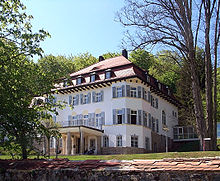Rabenstein (Zwiesel)
|
Rabenstein
City of Zwiesel
Coordinates: 49 ° 2 ′ 16 ″ N , 13 ° 12 ′ 6 ″ E
|
|
|---|---|
| Height : | 694 m |
| Incorporation : | January 1, 1978 |
| Postal code : | 94227 |
| Area code : | 09922 |
|
The branch church of St. Johannes Nepomuk
|
|
Rabenstein is a district of the city of Zwiesel in the Lower Bavarian district of Regen .
location
Rabenstein is located about three kilometers northwest of Zwiesel at the foot of the Hennenkobel .
history
Rabenstein was first mentioned between 1301 and 1312 under the name "Robenstain" in the Lower Bavarian Salbuch Monumenta Boica . There was a glassworks here as early as 1421 , in which slugs and pearls for rosaries were made, hence the name "Paternosterhütte".
Rabenstein was also a typical place for glassmakers in the following centuries. The first hut was in the middle of the village. In 1552 a hut owner Thomas Rabensteiner was mentioned, followed by Hans Rabensteiner. In 1596 Georg Rabensteiner was the smelter here. More huts were added later, but they closed again by 1758. In 1636 the Zwiesel regional court sold the Rabenstein smelter to Jakob Greiner. It was acquired by Franz Hilz in 1741, and in 1744 by Felix Martin Kiesling, who gave birth to the widow Anna Maria Hilz, nee. Stadler married, Hüttenmeister. The Kiesling family, owned by Kiesling since 1793, was very important to Rabenstein until 1847. On January 15, 1847, the heirs sold the estate with 6,212 daily work and 45 houses and significant forest holdings to the state for 300,000 guilders .
In 1785, a Kiesling built the "Old Castle", a manor house that was occupied in 1847 by a royal forest ranger. It now served as a forestry office and fell victim to a fire on December 17, 1961. The schoolhouse was also built in 1785 and demolished in 1992.
At the Hennenkobel there was a quartz quarry nearby, which later became an important mineral find. Here, at the abandoned town of Althütte, a glassworks was built again in 1817 in place of an abandoned hut, but it burned down in 1820. In 1822 a hut was built in its place in Schachtenbach, which was moved to Regenhütte in 1850 .
The legendary forest prophet Mühlhiasl is said to have lived in Rabenstein as a cattle herder or at least, if Mühlhiasl is a construction of two different people, the "forest prophet" Stormberger.
In the vicinity of Rabenstein is the abandoned hamlet of Ableg , which was first inhabited by glassmakers and ash burners and later woodcutters until the mid-1960s.
The community of Rabenstein
Rabenstein belonged to the municipality of Klautzenbach from 1821 to 1866. On August 15, 1866, Rabenstein was hived off from Klautzenbach and became an independent municipality and retained this status until the end of 1977. It had the following mayors:
|
|
The Rabenstein Forestry Office, which had existed since 1847, was dissolved in 1973 and incorporated into the Bodenmais Forestry Office . On January 1, 1978, Rabenstein was reclassified to Zwiesel as part of the municipal reform , while the Regenhütte district with Schachtenbach was reclassified to Bayerisch Eisenstein . Rabenstein is also a tourist and winter sports destination. On December 31, 2006, Rabenstein had 749 inhabitants.
Attractions
- The former St. Georg palace chapel from 1815 has a neo-Gothic altar.
- The former Schlossstadel from 1767 was converted into the Catholic branch church of St. Johannes Nepomuk in 1966. She received a rococo altar from Niederaltaich Monastery , which had previously stood in the castle chapel. It was made around 1750 in the monastery carpenter's workshop by Benjamin Schretter from Hengersberg and stood in a side chapel of the monastery. After the secularization , the Kieslings bought it for their chapel.
- New lock. The original villa, a wooden structure in the Venetian style, was built in 1863 by the last glassworks leaseholder, Wilhelm Steigerwald , and operated by various owners as a guesthouse. In the spring of 1912 Egon von Poschinger von Theresienthal bought it , had it torn down and replaced with the New Palace.
societies
- Boys' association Rabenstein
- Village association Rabenstein e. V.
- Rabenstein volunteer fire brigade
- Rabenstein men's choir
- SpVgg. Rabenstein-Klautzenbach eV
- Rabenstein gymnastics club
- Rabenstein winter sports club
Individual evidence
- ^ Wilhelm Volkert (ed.): Handbook of Bavarian offices, communities and courts 1799–1980 . CH Beck, Munich 1983, ISBN 3-406-09669-7 , p. 553 .
Web links
literature
- Reinhard Haller u. a .: Rabenstein - A village at the foot of the Hennenkobel , self-published by Dorfverein Rabenstein, 2011



